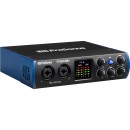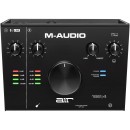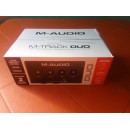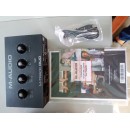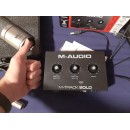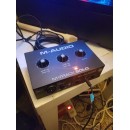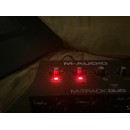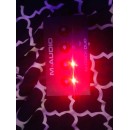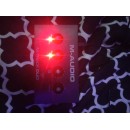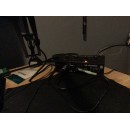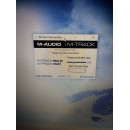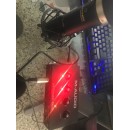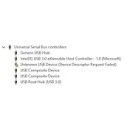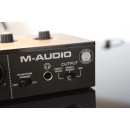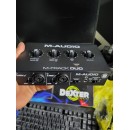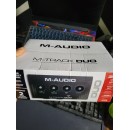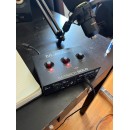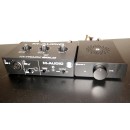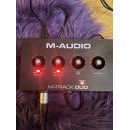M-Audio AIR 192|4 vs PreSonus Studio 24c: Which USB Audio Interface Reigns Supreme?
The PreSonus Studio 24c boasts a robust build and delivers crystal-clear audio quality with its XMAX-L mic preamps. It supports resolutions up to 24-bit/192 kHz, ensuring professional-grade recordings. The interface includes two front-panel combo inputs with globally switched 48V phantom power, suitable for both microphones and instruments. An LED metering feature provides real-time visual feedback, aiding in optimal gain staging. Additionally, the Studio 24c comes bundled with PreSonus’ Studio One Artist DAW software and the Studio Magic Plug-in Suite, providing users with a comprehensive suite of tools for music production right out of the box.
On the other hand, the M-Audio AIR 192|4 offers ultra-low latency and pristine audio fidelity, also supporting resolutions up to 24-bit/192 kHz. It features two front-panel inputs: one XLR+¼” TRS combo input and one ¼” instrument input, each with dedicated gain controls. The AIR 192|4 stands out with its sleek, modern design and high-speed USB-C connectivity. It also includes VU LED meters and a large central knob for easy control over output levels. M-Audio sweetens the deal with a software package that includes Pro Tools | First, Ableton Live Lite, and various virtual instruments and effects, providing a solid foundation for recording and production.
Both interfaces offer MIDI I/O, making them versatile for integrating with other MIDI gear. While the PreSonus Studio 24c shines with its comprehensive software suite and reliable XMAX-L preamps, the M-Audio AIR 192|4 excels in user-friendly design and low-latency performance. Ultimately, your choice may hinge on whether you prioritize bundled software and preamp quality (PreSonus) or ease of use and sleek design (M-Audio).
In-Depth Specifications and Reviews: M-Audio AIR 192|4 vs PreSonus Studio 24c
| User Rating Based on Analysis of Reviews | |
|---|---|
|
Show More |
| Pros: | |
|---|---|
|
|
| Cons: | |
|---|---|
|
|
| Find Best Price | Find Best Price |
| Key Specs | |
|---|---|
| Channels of I/O | |
| Analog: 2 Inputs / 2 Outputs at 192 kHz |
Analog: 2 Inputs / 2 Outputs at 192 kHz |
| Maximum Sampling Rate | |
| 192 kHz / 24-Bit | 192 kHz / 24-Bit |
| Number of Microphone Inputs | |
| 2 Preamps | 1 Preamp |
| Analog Audio I/O | |
| 2x Combo XLR-1/4" TRS Balanced/Unbalanced Mic/Line/Hi-Z Input 2x 1/4" TRS Balanced Line/Monitor Output 1x 1/4" TRS Unbalanced Headphone Output |
1x Combo XLR-1/4" TRS Balanced Mic/Line Input 1x 1/4" TS Unbalanced Hi-Z Input (Front Panel) 2x 1/4" TRS Balanced Line Output 1x 1/4" TRS Unbalanced Headphone Output (Front Panel) |
| Host Connection | |
| 1x USB-C (Class-Compliant) | 1x USB-C (Class-Compliant) |
| OS Compatibility | |
| macOS 10.13 or Later (64-Bit Only) Windows 10 or Later (64-Bit Only) |
macOS 10.8 or Later Windows 7 or Later |
| Power Requirements | |
| USB Bus Power | USB Bus Power |
Starting with the PreSonus Studio 24c, this interface supports a maximum sampling rate of 192 kHz at 24-bit resolution. It includes two microphone preamps, allowing for two simultaneous mic inputs via its combo XLR-1/4" TRS balanced/unbalanced inputs. In addition to these inputs, it features two 1/4" TRS balanced line/monitor outputs and a 1/4" TRS unbalanced headphone output. The device is class-compliant and connects via a single USB-C port. It is compatible with macOS 10.13 or later (64-bit only) and Windows 10 or later (64-bit only). The interface is powered via USB bus, eliminating the need for an external power source.
On the other hand, the M-Audio AIR 192|4 also supports a maximum sampling rate of 192 kHz at 24-bit resolution but includes only one microphone preamp. It offers a single combo XLR-1/4" TRS balanced mic/line input along with a separate 1/4" TS unbalanced Hi-Z input on the front panel, catering to instrument inputs such as electric guitars. The analog audio outputs include two 1/4" TRS balanced line outputs and a 1/4" TRS unbalanced headphone output, also located on the front panel. Similar to the PreSonus model, the M-Audio AIR 192|4 connects via USB-C and is class-compliant. It is compatible with macOS 10.8 or later and Windows 7 or later. This interface is also USB bus-powered.
In summary, while both interfaces share the same maximum sampling rate and bit depth, the PreSonus Studio 24c offers more flexibility with two microphone inputs compared to the single mic input of the M-Audio AIR 192|4. However, the M-Audio AIR 192|4 provides a dedicated Hi-Z input that might be more convenient for certain users, especially those who frequently record electric instruments. Compatibility wise, the PreSonus model requires more recent operating systems, whereas the M-Audio device supports older versions. Both are powered via USB, simplifying their use by eliminating the need for external power supplies.
| General | |
|---|---|
| Channels of I/O | |
| Analog: 2 Inputs / 2 Outputs at 192 kHz |
Analog: 2 Inputs / 2 Outputs at 192 kHz |
| Maximum Sampling Rate | |
| 192 kHz / 24-Bit | 192 kHz / 24-Bit |
| Number of Microphone Inputs | |
| 2 Preamps | 1 Preamp |
| Input Level Adjustment | |
| 2x Knob | 2x Knob |
| Expansion Slots | |
Both interfaces offer 2x2 analog channels of input and output at a maximum sampling rate of 192 kHz with a 24-bit resolution, ensuring high-quality audio recording and playback. This high sampling rate and bit depth are consistent across both devices, making them suitable for professional audio production.
However, a significant difference lies in the number of microphone inputs. The PreSonus Studio 24c provides 2 preamp microphone inputs, which can be advantageous for users who need to record multiple sources simultaneously, such as in a vocal and instrument setup. In contrast, the M-Audio AIR 192|4 offers only 1 preamp microphone input, which might limit recording capabilities for users who require more than one microphone input at the same time.
Both interfaces feature 2x knob input level adjustments, allowing users to easily control the input levels for optimal recording quality. This feature ensures that both interfaces provide straightforward and intuitive control over audio inputs.
In terms of expansion slots, both the PreSonus Studio 24c and the M-Audio AIR 192|4 do not offer any, indicating that neither device supports additional modules or cards for expanding their capabilities.
In summary, both the PreSonus Studio 24c and M-Audio AIR 192|4 offer high-resolution audio capabilities with similar basic features. However, the PreSonus Studio 24c stands out with its two microphone preamp inputs compared to the single preamp input of the M-Audio AIR 192|4, potentially making it a more versatile choice for users needing to record multiple microphones simultaneously.
| Signal Processing | |
|---|---|
| Pad | |
| Gain/Trim Range | |
| Inputs: 50 dB |
Mic/Line Inputs: 55 dB Hi-Z Inputs: 24 dB |
| High-Pass Filter | |
| Solo/Mute | |
Both the PreSonus Studio 24c and the M-Audio AIR 192|4 do not include a pad, high-pass filter, or solo/mute functionality, making them similar in terms of these specific features. However, when it comes to gain/trim range, there is a noticeable difference. The PreSonus Studio 24c offers a gain/trim range of 50 dB for its inputs, which is slightly lower than the M-Audio AIR 192|4. The M-Audio AIR 192|4 provides a gain/trim range of 55 dB for its mic/line inputs and 24 dB for its Hi-Z inputs.
This difference in gain/trim range means the M-Audio AIR 192|4 may offer more flexibility and control, particularly with microphone and line-level inputs, compared to the PreSonus Studio 24c. This could be a deciding factor for users who require a broader range of gain adjustments.
| Connectivity | |
|---|---|
| Analog Audio I/O | |
| 2x Combo XLR-1/4" TRS Balanced/Unbalanced Mic/Line/Hi-Z Input 2x 1/4" TRS Balanced Line/Monitor Output 1x 1/4" TRS Unbalanced Headphone Output |
1x Combo XLR-1/4" TRS Balanced Mic/Line Input 1x 1/4" TS Unbalanced Hi-Z Input (Front Panel) 2x 1/4" TRS Balanced Line Output 1x 1/4" TRS Unbalanced Headphone Output (Front Panel) |
| Phantom Power | |
| 48 V, Selectable On/Off (Applied to All Inputs) | 48 V, Selectable On/Off |
| Digital Audio I/O | |
| Host Connection | |
| 1x USB-C (Class-Compliant) | 1x USB-C (Class-Compliant) |
| Host Connection Protocol | |
| USB 2.0 | USB 2.0 |
| USB (Non-Host) | |
| Sync I/O | |
| Network I/O | |
| MIDI I/O | |
| 1x DIN 5-Pin Input 1x DIN 5-Pin Output |
|
Starting with analog audio I/O, the PreSonus Studio 24c offers 2x Combo XLR-1/4" TRS Balanced/Unbalanced Mic/Line/Hi-Z Inputs, which allow for versatile connectivity options for microphones, instruments, and line-level devices. It also provides 2x 1/4" TRS Balanced Line/Monitor Outputs and 1x 1/4" TRS Unbalanced Headphone Output. On the other hand, the M-Audio AIR 192|4 has a slightly different configuration with 1x Combo XLR-1/4" TRS Balanced Mic/Line Input and 1x 1/4" TS Unbalanced Hi-Z Input (Front Panel) for instruments. It also includes 2x 1/4" TRS Balanced Line Outputs and 1x 1/4" TRS Unbalanced Headphone Output (Front Panel).
Both interfaces offer 48 V selectable phantom power for condenser microphones, but the PreSonus Studio 24c specifies a phantom power current of 10 mA, a detail not provided by the M-Audio AIR 192|4. Neither unit features digital audio I/O, sync I/O, or network I/O.
For host connection, both interfaces use a USB-C connection that is class-compliant and operates on USB 2.0 protocol, ensuring compatibility with modern computers. Neither device includes additional USB (Non-Host) ports.
A significant differentiator is the MIDI I/O capability. The PreSonus Studio 24c includes 1x DIN 5-Pin Input and 1x DIN 5-Pin Output for MIDI devices, making it suitable for users who need to integrate MIDI equipment into their setup. In contrast, the M-Audio AIR 192|4 does not offer MIDI I/O, which might be a limitation for users looking to connect MIDI instruments or controllers directly to their audio interface.
In summary, the PreSonus Studio 24c offers more comprehensive connectivity options, especially with its dual combo inputs and MIDI I/O, making it a versatile choice for various recording setups. The M-Audio AIR 192|4, while also offering high-quality audio performance, provides a simpler input configuration and lacks MIDI connectivity, which may be a consideration for users depending on their specific needs.
| Performance | |
|---|---|
| Frequency Response | |
| Mic Inputs: 20 Hz to 20 kHz ±0.3 dB (Unity Gain) Hi-Z Inputs: 20 Hz to 20 kHz ±0.1 dB (Unity Gain) Monitor Outputs: 20 Hz to 20 kHz ±0.3 dB (Unity Gain) Headphone Outputs: 20 Hz to 20 kHz ±0.5 dB (Unity Gain) |
Mic Inputs: 20 Hz to 20 kHz +0.1 dB Line, Hi-Z Inputs: 20 Hz to 20 kHz ±0.05 dB Monitor Outputs: 20 Hz to 20 kHz +0.06 dB |
| Maximum Input Level | |
| Mic Inputs: +10 dBu (Min Gain) Hi-Z Inputs: +19 dBu (Min Gain) |
Mic Inputs: +1.5 dBu Line Inputs: +16 dBu Hi-Z Inputs: +6 dBu |
| Maximum Output Level | |
| Monitor Outputs: +10 dBu (Balanced) |
Line Outputs: +7 dBu (Balanced, 1 kHz) |
| Impedance | |
| Mic Inputs: 1.4 Kilohms Hi-Z Inputs: 750 Kilohms Headphone Outputs: 32 to 300 Ohms |
Hi-Z Inputs: 1 Megohm (Unbalanced) Headphone Outputs: 10 Ohms (Balanced) |
| Dynamic Range | |
| AD/DA Converters: 108 dB Mic Inputs: 106 dBA Hi-Z Inputs: 105 dBA Monitor Outputs: 104 dB (Unweighted) Headphone Outputs: 83 dBA |
Mic Inputs: 104 dB (A-Weighted) Hi-Z Inputs: 100 dB (A-Weighted) Monitor Outputs: 102 dB (A-Weighted) |
| THD+N | |
| Mic Inputs: 0.004% (1 kHz, Min Gain, at -1 dBFS) Hi-Z Inputs: 0.002% (1 kHz, Min Gain) Monitor Outputs: 0.001% (1 kHz, Unity Gain, at -1 dBFS) Headphone Outputs: 0.01% (1 kHz, at 0 dBFS) |
Mic/Line Inputs: 0.003% Hi-Z Inputs: 0.004% Headphone/Monitor Outputs: 0.005% |
| EIN | |
| Mic Inputs: -126 dBu A-Weighted |
Mic Inputs: -128 dBu A-Weighted (150-Ohm Source, Max Gain) |
Starting with frequency response, the PreSonus Studio 24c offers mic inputs with a response of 20 Hz to 20 kHz ±0.3 dB, Hi-Z inputs at 20 Hz to 20 kHz ±0.1 dB, monitor outputs at 20 Hz to 20 kHz ±0.3 dB, and headphone outputs at 20 Hz to 20 kHz ±0.5 dB. In comparison, the M-Audio AIR 192|4 provides a slightly tighter frequency response for mic inputs at 20 Hz to 20 kHz +0.1 dB, line/Hi-Z inputs at 20 Hz to 20 kHz ±0.05 dB, and monitor outputs at 20 Hz to 20 kHz +0.06 dB.
In terms of maximum input level, the PreSonus Studio 24c handles mic inputs up to +10 dBu, Hi-Z inputs up to +19 dBu, while the M-Audio AIR 192|4 handles mic inputs up to +1.5 dBu, line inputs up to +16 dBu, and Hi-Z inputs up to +6 dBu.
For maximum output level, the PreSonus Studio 24c offers +10 dBu for monitor outputs and 47 mW per channel into 56 Ohms for headphone output power. The M-Audio AIR 192|4 has a maximum line output level of +7 dBu (balanced, 1 kHz).
Regarding impedance, the PreSonus Studio 24c features mic inputs at 1.4 Kilohms, Hi-Z inputs at 750 Kilohms, and headphone outputs supporting 32 to 300 Ohms. The M-Audio AIR 192|4 presents Hi-Z inputs at 1 Megohm (unbalanced) and headphone outputs at 10 Ohms (balanced).
Dynamic range comparisons show the PreSonus Studio 24c with AD/DA converters at 108 dB and mic inputs at 106 dBA, Hi-Z inputs at 105 dBA, monitor outputs at 104 dB (unweighted), and headphone outputs at 83 dBA. The M-Audio AIR 192|4 offers mic inputs at 104 dB (A-weighted), Hi-Z inputs at 100 dB (A-weighted), and monitor outputs at 102 dB (A-weighted).
Examining THD+N (Total Harmonic Distortion plus Noise), the PreSonus Studio 24c records mic inputs at 0.004% (1 kHz, min gain, at -1 dBFS), Hi-Z inputs at 0.002% (1 kHz, min gain), monitor outputs at 0.001% (1 kHz, unity gain, at -1 dBFS), and headphone outputs at 0.01% (1 kHz, at 0 dBFS). The M-Audio AIR 192|4 lists mic/line inputs at 0.003%, Hi-Z inputs at 0.004%, and headphone/monitor outputs at 0.005%.
Finally, for Equivalent Input Noise (EIN), the PreSonus Studio 24c specifies mic inputs at -126 dBu A-weighted, while the M-Audio AIR 192|4 lists mic inputs at -128 dBu A-weighted (150-Ohm source, max gain).
Overall, both interfaces offer high-quality performance, but the PreSonus Studio 24c shows slightly better specifications in dynamic range and THD+N, while the M-Audio AIR 192|4 presents a tighter frequency response and lower EIN.
| Digital Audio | |
|---|---|
| Sample Rates | |
| Up to 192 kHz (AD/DA Conversion) | Up to 192 kHz (AD/DA Conversion) |
| Sample Rate Conversion | |
| Bit Depths | |
| Up to 24-Bit (AD/DA Conversion) | 24-Bit (AD/DA Conversion) |
| Sync Sources | |
| Internal | Internal |
Both interfaces support sample rates of up to 192 kHz for Analog-to-Digital (AD) and Digital-to-Analog (DA) conversion, ensuring high-resolution audio recording and playback capabilities. Similarly, both devices offer a bit depth of up to 24-bit for AD/DA conversion, which is standard for professional audio interfaces and provides a wide dynamic range and low noise floor.
However, the M-Audio AIR 192|4 includes a specification for latency, reporting a latency of 2.59 ms. This latency can vary depending on the buffer size and other factors, but the inclusion of this detail can be crucial for users who require real-time audio processing with minimal delay. The PreSonus Studio 24c does not specify its latency, which might make it less appealing to those who prioritize low-latency performance for tasks such as live monitoring or real-time effects processing.
Both interfaces use internal sync sources, which means they rely on their internal clocks to maintain timing accuracy. This is typical for small desktop audio interfaces and is suitable for most home studio applications.
In summary, while both the PreSonus Studio 24c and the M-Audio AIR 192|4 offer high sample rates and bit depths, the M-Audio AIR 192|4 provides additional information about its low-latency performance, which could be a decisive factor for users needing real-time audio processing capabilities.
| Audio Storage & Playback | |
|---|---|
| Memory Card Slot | |
The PreSonus Studio 24c is a 2x2 audio/MIDI interface that connects via USB Type-C. It is designed for high-definition recording and offers professional-grade 24-bit/192 kHz audio quality. It features two front-panel combo mic/instrument/line inputs with XMAX-L solid-state mic preamps, and two balanced TRS outputs. The interface includes a MIDI I/O for connecting external MIDI gear such as keyboards and controllers. It also features a mix control for blending the input signal with the computer playback, which is useful for zero-latency monitoring. Additionally, it has an LED metering on the front panel for monitoring input and output levels. One notable aspect is that it does not include a memory card slot, which means users must rely on their connected computer or external storage solutions for data management.
The M-Audio AIR 192|4 is also a 2x2 audio interface that connects via USB Type-C. It supports high-resolution 24-bit/192 kHz audio and features a rugged metal chassis for durability. The interface includes two front-panel combo inputs with Crystal preamps and pristine A/D converters, which ensure clear and transparent audio capture. It also offers two balanced outputs and a quarter-inch headphone output with independent level control. The M-Audio AIR 192|4 features a USB/Direct knob for zero-latency monitoring, allowing users to blend the input signal with the playback from their computer. Just like the PreSonus Studio 24c, the M-Audio AIR 192|4 lacks a memory card slot, indicating that data storage must be managed through external means.
Both interfaces provide similar core functionalities with high-quality audio recording and playback, zero-latency monitoring, and durable design. They both connect via USB Type-C and offer 24-bit/192 kHz audio resolution. However, the PreSonus Studio 24c additionally includes MIDI I/O, making it a potentially better option for users who need to integrate MIDI equipment into their setup. On the other hand, the M-Audio AIR 192|4 focuses on offering a sturdy build and easy-to-use design without the need for MIDI integration. Both lack memory card slots, so users will need to manage storage separately.
| Compatibility | |
|---|---|
| OS Compatibility | |
| macOS 10.13 or Later (64-Bit Only) Windows 10 or Later (64-Bit Only) |
macOS 10.8 or Later Windows 7 or Later |
| Mobile Device Compatibility | |
| Required Hardware | |
| USB Cable (Included) Available USB 2.0 Port or USB-C Port |
Available USB 2.0 Port or USB-C Port USB Cable (Included) |
| Internet Connection | |
| Required for Registration, Software/Driver Download | Required for Registration, Software/Driver Download |
The PreSonus Studio 24c is compatible with macOS 10.13 or later (64-bit only) and Windows 10 or later (64-bit only). It requires at least an Intel Core i3 processor for both Mac and PC, with a recommendation of 4 GB RAM, though 8 GB is preferred. Storage requirements are 30 GB, and the minimum display resolution is 1366 x 768. The interface is not compatible with mobile devices and necessitates a USB cable (which is included) and an available USB 2.0 or USB-C port. An internet connection is required for registration and software/driver downloads.
In contrast, the M-Audio AIR 192|4 offers broader OS compatibility, supporting macOS 10.8 or later and Windows 7 or later. Like the PreSonus model, it does not support mobile device compatibility. The necessary hardware includes an available USB 2.0 or USB-C port, and a USB cable is included with the device. Similar to the PreSonus, an internet connection is essential for registration and software/driver downloads.
Both interfaces require a similar hardware setup, including a USB port and internet connection for essential updates and registrations. The PreSonus demands more recent operating systems and has higher minimum system requirements in terms of processor, RAM, and storage, which may provide an edge in performance but could limit compatibility with older systems. The M-Audio AIR 192|4 offers wider OS compatibility, potentially making it more versatile for users with older operating systems.
| Power | |
|---|---|
| Power Requirements | |
| USB Bus Power | USB Bus Power |
The PreSonus Studio 24c and M-Audio AIR 192|4 are designed with portability and convenience in mind. Their reliance on USB bus power makes them ideal for mobile recording setups or home studios where minimizing extra cables and power adapters is crucial. This feature also simplifies the process of connecting the interface to a computer, as users only need a single USB Type-C cable for both data transfer and power.
In summary, both the PreSonus Studio 24c and the M-Audio AIR 192|4 offer the convenience of USB bus power, making them efficient and easy to integrate into various recording environments without the need for additional power sources. This shared feature underscores their suitability for users seeking a straightforward and portable audio interface solution.
| Physical | |
|---|---|
| Anti-Theft Features | |
| Kensington Security Slot | Kensington Security Slot |
| Dimensions | |
| 7 x 5.5 x 1.75" / 17.8 x 14 x 4.45 cm | 8 x 6 x 2.76" / 20.3 x 15.2 x 7.01 cm |
| Weight | |
| 2.0 lb / 0.9 kg | 2.0 lb / 0.9 kg |
Both interfaces are equipped with anti-theft features, specifically the Kensington Security Slot, which is a standard feature for securing devices in public or shared spaces. This ensures that both devices can be securely locked, providing peace of mind to their users.
In terms of physical dimensions, the PreSonus Studio 24c measures 7 x 5.5 x 1.75 inches (17.8 x 14 x 4.45 cm), making it slightly more compact compared to the M-Audio AIR 192|4, which measures 8 x 6 x 2.76 inches (20.3 x 15.2 x 7.01 cm). The smaller footprint of the PreSonus Studio 24c might be more appealing to users with limited desk space or those who prefer a more portable option.
Despite the difference in size, both interfaces weigh the same, with each unit coming in at 2.0 lb (0.9 kg). This weight makes both devices relatively lightweight and easy to transport, ensuring that neither adds significant bulk to a portable recording setup.
In summary, while the PreSonus Studio 24c is more compact, both it and the M-Audio AIR 192|4 offer similar anti-theft features and weight, making them both viable options for users looking for a reliable and portable audio interface.
| Packaging Info | |
|---|---|
| Package Weight | |
| 2.285 lb | 2.85 lb |
| Box Dimensions (LxWxH) | |
| 7.8 x 7.5 x 2" | 11 x 7.5 x 4.8" |
The PreSonus Studio 24c has a package weight of 2.285 lb and its box dimensions are 7.8 x 7.5 x 2 inches. This relatively compact and lightweight design makes it a portable choice for musicians and producers who need to record on the go. The interface offers a range of connectivity options, including MIDI, which adds flexibility for integrating various musical instruments and equipment.
On the other hand, the M-Audio AIR 192|4 has a slightly heavier package weight of 2.85 lb and larger box dimensions of 11 x 7.5 x 4.8 inches. While it is bulkier compared to the PreSonus Studio 24c, the M-Audio AIR 192|4 is known for its high-quality audio performance, offering low-latency monitoring and high-resolution audio recording. The extra weight and size may cater to users looking for a more stationary setup with potentially more robust build quality.
Both interfaces use USB Type-C connectors, ensuring fast and reliable data transfer, which is crucial for high-quality audio recording. However, the choice between these two may come down to the user's need for MIDI connectivity, portability, and the specific audio quality requirements.
| Customer Images | |
|---|---|
| Videos | |
|---|---|
|
|
|
